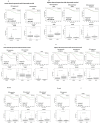Genomic instability genes in lung and colon adenocarcinoma indicate organ specificity of transcriptomic impact on Copy Number Alterations
- PMID: 35817785
- PMCID: PMC9273645
- DOI: 10.1038/s41598-022-15692-8
Genomic instability genes in lung and colon adenocarcinoma indicate organ specificity of transcriptomic impact on Copy Number Alterations
Abstract
Genomic instability (GI) in cancer facilitates cancer evolution and is an exploitable target for therapy purposes. However, specific genes involved in cancer GI remain elusive. Causal genes for GI via expressions have not been comprehensively identified in colorectal cancers (CRCs). To fill the gap in knowledge, we developed a data mining strategy (Gene Expression to Copy Number Alterations; "GE-CNA"). Here we applied the GE-CNA approach to 592 TCGA CRC datasets, and identified 500 genes whose expression levels associate with CNA. Among these, 18 were survival-critical (i.e., expression levels correlate with significant differences in patients' survival). Comparison with previous results indicated striking differences between lung adenocarcinoma and CRC: (a) less involvement of overexpression of mitotic genes in generating genomic instability in the colon and (b) the presence of CNA-suppressing pathways, including immune-surveillance, was only partly similar to those in the lung. Following 13 genes (TIGD6, TMED6, APOBEC3D, EP400NL, B3GNT4, ZNF683, FOXD4, FOXD4L1, PKIB, DDB2, MT1G, CLCN3, CAPS) were evaluated as potential drug development targets (hazard ratio [> 1.3 or < 0.5]). Identification of specific CRC genomic instability genes enables researchers to develop GI targeting approach. The new results suggest that the "targeting genomic instability and/or aneuploidy" approach must be tailored for specific organs.
© 2022. The Author(s).
Conflict of interest statement
The authors declare no competing interests.
Figures




Similar articles
-
Survival-Critical Genes Associated with Copy Number Alterations in Lung Adenocarcinoma.Cancers (Basel). 2021 May 25;13(11):2586. doi: 10.3390/cancers13112586. Cancers (Basel). 2021. PMID: 34070461 Free PMC article.
-
DNA copy number alterations, gene expression changes and disease-free survival in patients with colorectal cancer: a 10 year follow-up.Cell Oncol (Dordr). 2016 Dec;39(6):545-558. doi: 10.1007/s13402-016-0299-z. Epub 2016 Oct 5. Cell Oncol (Dordr). 2016. PMID: 27709558
-
Mucinous adenocarcinoma of the colon and rectum: A genomic analysis.J Surg Oncol. 2019 Dec;120(8):1427-1435. doi: 10.1002/jso.25764. Epub 2019 Nov 14. J Surg Oncol. 2019. PMID: 31729037
-
The landscape of genomic copy number alterations in colorectal cancer and their consequences on gene expression levels and disease outcome.Mol Aspects Med. 2019 Oct;69:48-61. doi: 10.1016/j.mam.2019.07.007. Epub 2019 Aug 6. Mol Aspects Med. 2019. PMID: 31365882 Review.
-
Genomic instability and colon cancer.Cancer Metastasis Rev. 2004 Jan-Jun;23(1-2):11-27. doi: 10.1023/a:1025861527711. Cancer Metastasis Rev. 2004. PMID: 15000146 Review.
Cited by
-
Mutational disparities in colorectal cancers of White Americans, Alabama African Americans, And Oklahoma American Indians.NPJ Precis Oncol. 2024 Dec 23;8(1):288. doi: 10.1038/s41698-024-00782-9. NPJ Precis Oncol. 2024. PMID: 39715885 Free PMC article.
-
Identification of Genomic Instability-Associated LncRNAs as Potential Therapeutic Targets in Lung Adenocarcinoma.Cancers (Basel). 2025 Mar 15;17(6):996. doi: 10.3390/cancers17060996. Cancers (Basel). 2025. PMID: 40149330 Free PMC article.
-
Detection of LUAD-Associated Genes Using Wasserstein Distance in Multiomics Feature Selection.Bioengineering (Basel). 2025 Jun 25;12(7):694. doi: 10.3390/bioengineering12070694. Bioengineering (Basel). 2025. PMID: 40722386 Free PMC article.
References
Publication types
MeSH terms
Grants and funding
LinkOut - more resources
Full Text Sources
Medical
Miscellaneous

